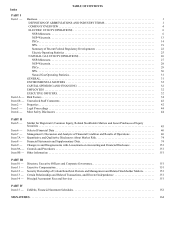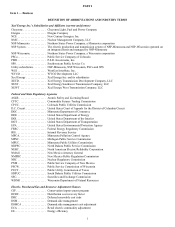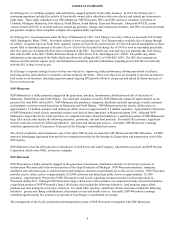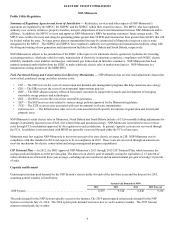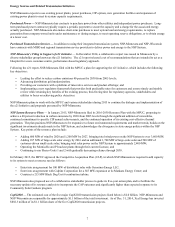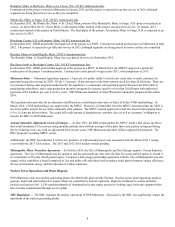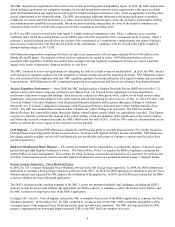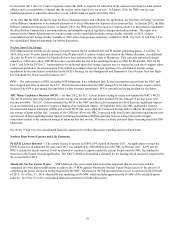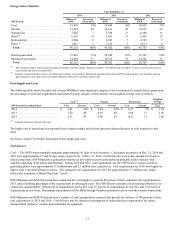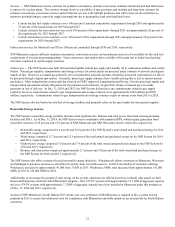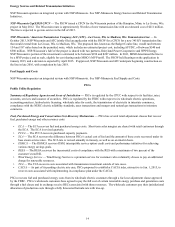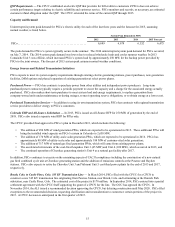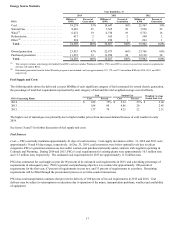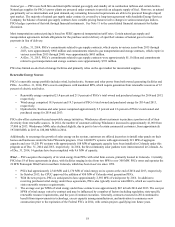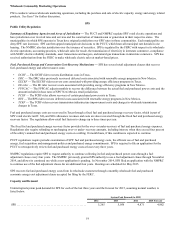Xcel Energy 2014 Annual Report Download - page 27
Download and view the complete annual report
Please find page 27 of the 2014 Xcel Energy annual report below. You can navigate through the pages in the report by either clicking on the pages listed below, or by using the keyword search tool below to find specific information within the annual report.
9
The NRC imposed new requirements after events at the nuclear generating plant in Fukushima, Japan. In 2012, the NRC issued orders
which included requirements for mitigation strategies for beyond-design-basis external events, requirements with regard to reliable
spent fuel instrumentation and requirements with regard to reliable hardened containment vents, which are applicable to boiling water
reactor containments at the Monticello plant. The NRC also requested additional information including requirements to perform
walkdowns of seismic and flood protection, to evaluate seismic and flood hazards and to assess the emergency preparedness staffing
and communications capabilities at each plant. Based on current refueling outage plans, the dates of the required compliance are
expected to begin in 2015 with all units expected to be fully compliant by December 2016.
In 2013, the NRC issued a revised order with regard to reliable hardened containment vents. Phase 1 addresses severe accident
conditions under which the existing hardened vent which comes off of the wet portion of the containment needs to operate. Phase 2
addresses a second hardened vent off of the dry portion of the containment, or a containment venting strategy that makes it unlikely
that a licensee would need to vent from the dry portion of the containment. Compliance with the revised order will be completed
during refueling outages in 2017-2019.
NSP-Minnesota expects that complying with these external event requirements will cost approximately $90 to $100 million at the
Monticello and PI plants. The majority of these costs are expected to be capital in nature. NSP-Minnesota believes the costs
associated with compliance would be recoverable from customers through regulatory mechanisms and does not expect a material
impact on its results of operations, financial position, or cash flows.
The NRC continues to review its requirements for mitigating the risks of external events on nuclear plants. In 2014, the NRC issued a
draft of proposed regulatory guidance for risk mitigation of tornado missiles (projectiles impacting the plant). NSP-Minnesota expects
the costs associated with compliance with new NRC regulatory guidance for missile protection to be capital in nature and recoverable
from customers. NSP-Minnesota is still evaluating the proposed new requirements and has not yet estimated their financial impact.
Nuclear Regulatory Performance — Since 2000, the NRC has had in place a Reactor Oversight Process (ROP) that classifies U.S.
nuclear reactors into various categories (referred to as Columns, from 1 to 5) based on the significance of issues identified in
performance indicators or inspection findings. Such issues are evaluated as either green, white, yellow, or red based on their safety
significance, with green representing the least safety concern and red representing the most concern. At Dec. 31, 2014, PI Units 1 and
2 were in Column 1 (Licensee Response) with all green performance indicators and no greater than green findings or violations.
Monticello was in Column 3 (Degraded Cornerstone) with all green performance indicators and a yellow finding related to flood
control. The NRC has completed their inspection that will allow the yellow finding to be closed out. The NRC has notified
Monticello that it has a potentially greater than green finding related to plant security which was immediately remedied. Xcel Energy
expects to be formally notified of the closeout of the yellow finding, a final determination of the significance of the security finding,
and Monticello’s overall column status under the NRC’s ROP in the first half of 2015. Until the NRC makes its determination, we are
unable to estimate the cost or impact of any responsive actions required.
LLW Disposal — LLW from NSP-Minnesota’s Monticello and PI nuclear plants is currently disposed at the Clive facility located in
Utah and Waste Control Specialists facility located in Texas. If off-site LLW disposal facilities become unavailable, NSP-Minnesota
has storage capacity available on-site at PI and Monticello that would allow both plants to continue to operate until the end of their
current licensed lives.
High-Level Radioactive Waste Disposal — The federal government has the responsibility to permanently dispose of domestic spent
nuclear fuel and other high-level radioactive wastes. The Nuclear Waste Policy Act requires the DOE to implement a program for
nuclear high-level waste management. This includes the siting, licensing, construction and operation of a repository for spent nuclear
fuel from civilian nuclear power reactors and other high-level radioactive wastes at a permanent federal storage or disposal facility.
Nuclear Geologic Repository - Yucca Mountain Project
In 2002, the U.S. Congress designated Yucca Mountain, Nevada as the first deep geologic repository. In 2008, the DOE submitted an
application to construct a deep geologic repository at this site to the NRC. In 2010, the DOE announced its intention to stop the Yucca
Mountain project and requested the NRC approve the withdrawal of the application. In 2010, the ASLB issued a ruling that the DOE
could not withdraw the Yucca Mountain application.
The DOE’s decision and the resulting stoppage of the NRC’s review has prompted multiple legal challenges, including the DOE’s
authority to stop the project and withdraw the application, the DOE’s authority to continue to collect the nuclear waste fund fee and
the NRC’s authority to stop their review of the DOE’s application.
In August 2013, the D.C. Court of Appeals ordered the NRC to complete their review of the DOE’s application to construct the Yucca
Mountain repository. In November 2013, the NRC complied by issuing an order to the NRC Staff to complete and publish a safety
evaluation report on the proposed Yucca Mountain nuclear spent fuel and waste repository. The NRC also requested that the DOE
prepare a supplemental environmental impact statement (EIS) so the NRC Staff can complete its review.


